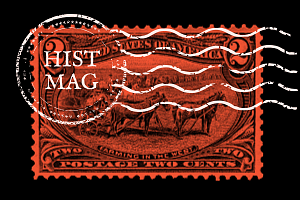Military and strategic issues of the conflicts in Chechnya (1994-2008)
Short history of Chechnya in the 20th century
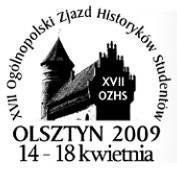 Artykuł stanowi podstawę referatu, który autor wygłosił na XVII Ogólnopolskim Zjeździe Historyków Studentów. Publikujemy go w oryginalnej formie anglojęzycznej – w razie zainteresowania Czytelników tekst zostanie opublikowany także w języku polskim.
Artykuł stanowi podstawę referatu, który autor wygłosił na XVII Ogólnopolskim Zjeździe Historyków Studentów. Publikujemy go w oryginalnej formie anglojęzycznej – w razie zainteresowania Czytelników tekst zostanie opublikowany także w języku polskim. After Bolshvka Revolution, territory inhabited by Chechens became a part of the Mountain Autonomous Soviet Socialist Republic. In that republic, in 1922, a Chechen Autonomous Oblast was separated, and then in 1924 it was incorporated into the Russian Soviet Federative Socialist Republic. Finally, in 1936 Chechen-Ingush ASSR of RSFSR was created. A forced collectivisation and atheisation was carried out there together with cleansing of the intellectual elite in the thirties. During the Second World War Germans seized part of the Caucasus and some Chechens organised a national uprising and collaborated with Nazis to fight for the independence from the Soviet Union. For that reason in 1944 Stalin decided to dissolve the Chechen-Ingush ASSR and to deport its citizens to Siberia and Kazakhstan.
Autonomy of the region was restored in 1957 during the destalinisation period and Chechens were allowed to return to their homeland. Although that, the russification process was continued, Russian language was privileged in schools, departments, etc.
When Soviet Union was collapsing, president Dudayev announced creation of the independent Chechnya, which finally led to the First and Second Chechen War.
The First Chechen War
The war started in 1994, when Russia sent an army to that Caucasian state, trying to stop secession of Chechnya, and ended in 1996, when a peace treaty was signed. Despite overwhelming power supremacy of the Federation troops, they couldn’t control rebellious province. An agreement, which finished warfare, granted de facto independence to Chechnya.
The Second Chechen War
On the 7th of August 1999, units of Shamil Basayev entered Dagestan, trying to support Islamic separatist rebels. In September 1999 series of bomb attacks took place in Russia and Chechens were blamed for them (although Alexander Litvinenko claimed in his book that those events were organised by Russian security services to give a pretext to invade Chechnya for the second time). In September 1999 air strikes began and on the 1st of October Russian army crossed the border of Chechnya. This time an offensive was prepared better, Russia established a control over the region and created a pro-Moscow government. In spite of this, Chechens are still organising guerrilla actions.
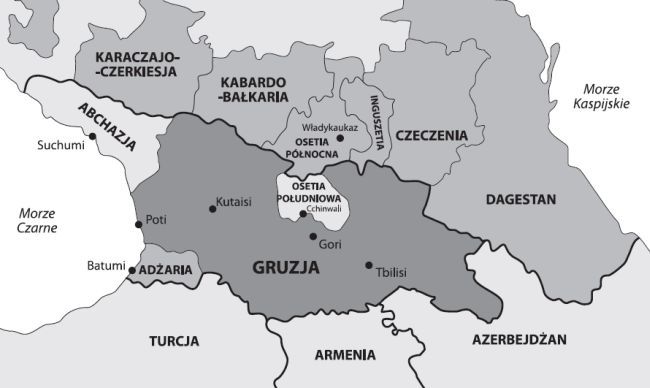 The map of the Caucasus from a book: Źródła nienawiści. Konflikty etniczne w krajach postkomunistycznych, ryc. Marek Ciesielczyk.
The map of the Caucasus from a book: Źródła nienawiści. Konflikty etniczne w krajach postkomunistycznych, ryc. Marek Ciesielczyk. Russian approach to the First Chechen War
During the communism era, the party took a position that national safety is guaranteed by nuclear weapons and a large army. Possible war was considered, as a clash “in central Europe against a highly skilled, technologically advanced adversary” in which heavy weapons like tube artillery or tanks would play a crucial role. Not much was changed after the Soviet Union collapsed – “General Stuff has been slow to abandon its fixation with ‘classic’ form of military operation”. Russian decision-makers didn’t treat Chechens and urban fights seriously; there was conviction, that a demonstration of force would be enough to pacify that region. That’s the reason why the columns of tanks supported by mounted infantry were sent to Grozny.
Beginning of the war
The arrogance and ignorance of Russian leaders can be clearly illustratedby a quotation from General Pavel Grachev (who was also a Minister of Defence during the First Chechen War), who claimed that it is possible “to take Grozny with one airborne assault regiment in two hours”. That kind of attitude and mentality contributed to a lack of preparation to an urban combat. When Russian army entered Grozny, it was really easy to spot – whole tank columns were destroyed, almost without an effort, because they were holding a strict formation. Russians also didn’t pay much attention to the weather conditions, which limited air support for the units. Boris Gromov said, that December, when the attack started, was “the worst time for the beginning of an operation: practically constant cloud cover leaves no possibility for effective use of aviation”.
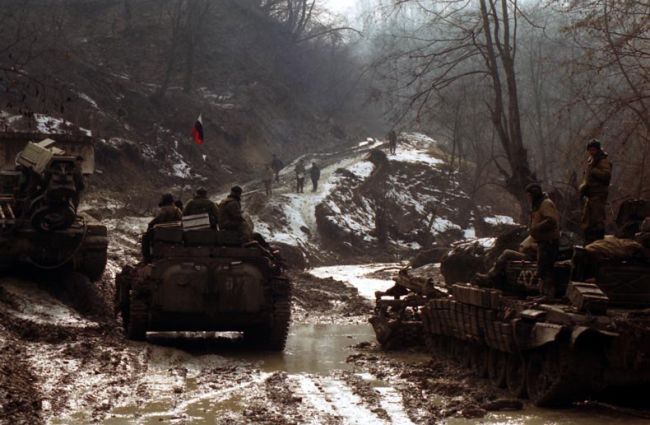 Tanks move into the mountain regions of Chechnya, 1995 (source).
Tanks move into the mountain regions of Chechnya, 1995 (source). Because of the attitude of the officers and a lack of money for manoeuvres, soldiers weren’t prepared for urban fights; no attention was given to that type of training. We can even extend this statement – they weren’t ready for a war. Pavel Grachev admitted that “some pilots are logging 15 to 20 hours a year. This is negligible... For a pilot to be in peak form he needs 150 to 200 hours flying time.” Peter Deynekin said: “because we only receive a third of what the Air Force needs [amount of money], our pilots are gradually losing their high level of training”. Not only they were untrained. Many soldiers didn’t even know how to use their equipment (for instance night-vision goggles or even weaponry). The best evidence for that are initial losses, which “demonstrated that predeployment training was insufficient”.
In respect to the equipment there were numerous cases when radio devices were incompatible witch each other. Moreover, Chechens had access to Russian communication system, because at the beginning of the war Federal Army didn’t use any encryption. The lack of communication between the units often led to a fratricide – one of the participants claimed that 60 percent of casualties were from a friendly-fire. There was also a problem with the maps of Chechnya – the scales were often wrong or sometimes soldiers weren’t equipped with them. Eduard Vorobev said: “My God, our tank troops went into battle without maps of the city!”
Another key factor was a coordination of action – too many different ministries and departments were in charge of the troops (Ministry of Defence, Ministry of Internal Affairs, Federal Security Bureau, etc) and they didn’t have much experience in working together, which led to a visible lack of collaboration. Moreover, responsibility for the defeats was blurred.
Changes during the war
When Russian politicians and army leaders realised, that their approach to the war was completely wrong and that the condition of the troops was really bad, some changes started to appear. First, during the battle of Grozny, some commanders were dismissed (for instance Staskov, Petgruk). Number of soldiers was increased to 30.000 and most of them were concentrated near the capitol of Chechnya. That decision gave Russia an overwhelming advantage over its enemy.
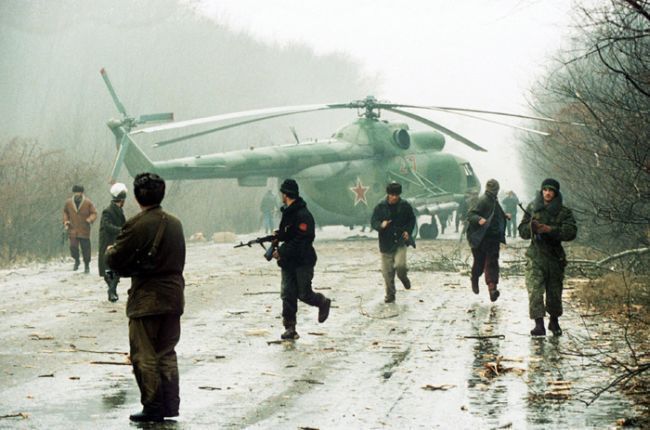 A Russian helicopter shot down by Chechen fighters near the Chechen capital, Grozny 1994 (fot. Mikhail Evstafiev, lic. CC ASA 2,5).
A Russian helicopter shot down by Chechen fighters near the Chechen capital, Grozny 1994 (fot. Mikhail Evstafiev, lic. CC ASA 2,5). The next step was organising the training camps in the province and sending well-prepared groups like Spetsnaz and snipers to the battlefield. Smaller tactical units were created, to make an urban fight more efficient (still there was again a problem with cooperation between those groups, although radio communication difficulties were solved). These changes resulted in much smaller number of casualties than at the beginning of the war, nonetheless they were insufficient to win this struggle.
Peace time – 1996-1999
After the First Chechen War Russian leaders realised that the army in the present state is not capable of fulfilling its basic duty – to protect the country and to ensure safety. A reform plan was introduced and came into effect, together with some personal changes. In July 1996 (the month before the war was over) Grachev was dismissed and Igor Rodionov became a new Russia’s Minister of Defence. The government also tried to solve a cooperation problem. In July 1998 Yeltsin signed ‘The Fundamentals (Concept) of State policy of the Russian Federation for Military Development in the Period up to the Year 2005”, which gave a high authority to the Military District Commander, who was now in charge of all the troops in the area. Anatoly Kvashnin, the Chef of the General Staff, explained purpose of the reform in the following words: “The substantial widening of the powers of the military district commander (...) pursues the following goals: improving the quality of planning of the use of the Armed Forces and other troops, military formations and organs of the Russian Federation on the interest of defence, as well as the organisation of collaboration, command and control and all-round support for them... improve the quality of operational and combat training measures for all troops.”
An interest was given to the new types of training, especially for a mountain combat and anti-insurgent operations. Snipers received tutorials on a range of operating environment. According to the words of Viktor Kazantsev Russia would like to achieve a situation “that in every regiment there is a motor rifle battalion which have single-mindedly trained to operate in the mountains” Finally, all of the troops (MoD, MVD, FSB, etc.) had performed joint manoeuvres.
More money was as well spent on training: “about 10% of the funds allocated to the military budget are being directed to military training”. Nonetheless urban training was still neglected, because the new strategy assumed avoiding it when possible. Igor Sergeyev also introduced the creation of the “units of the future” in 1998: troops with brand new equipment and access to good infrastructure. According to this plan, one of those units them should be situated in the North Caucasus Military District. Regular army equipment was to be replaced with modern weaponry as well. Nonetheless, we can still find and old Soviet thinking in the results of the reform – Kazanstev boasted of having a wide range of new tank artillery, which, in my opinion, isn’t usually the most important factor when you are fighting against rebels.
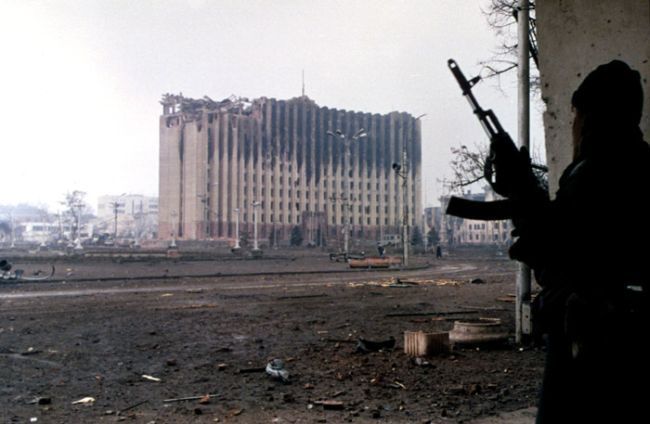 A Chechen fighter stands near the government palace building during a short lull in fighting in Grozny, January 1995 (fot. Mikhail Evstafiev, lic. CC ASA 2,5).
A Chechen fighter stands near the government palace building during a short lull in fighting in Grozny, January 1995 (fot. Mikhail Evstafiev, lic. CC ASA 2,5). Russian politicians also realised, that to ensure safety in the North Caucasus, it’s not enough to create a strong army, which enforces a momentary order. Some plans appeared on economical development of this region, which should prevent national minorities from rebelling. Nonetheless almost nothing was done to carry out these concepts.
Second Chechen War
Russia drew a conclusion from the First Chechen War and the approach to the combat was completely different. The most important stipulation was to minimise casualties by attacking from distance and preventing Chechens from getting closer than a few hundred meters. To achieve this aim a heavy artillery fire and air strikes were frequently used. Colonel General Karatuyev said: “We have proceeded from the principle that each motor riffle company, each airborne company must be reinforced with an artillery or mortar battery”. Frontal attack on Grozny was also rejected; instead city was encircled and before the seizure repeatedly fired by the artillery.
During the operations small storm detachment groups were created to play a crucial role during the sieges of the cities, towns and villages. Tanks, contrary to the first war, were playing only a supporting role. On the other hand snipers, RPG and flame-thrower units were vitally important.
Although training before sending troops to Chechnya was still inefficient, we could see a significant progress. Regulations forbade going into combat if a soldier didn’t spend at least a few months in the army (still there were such cases, “some units were found to have up to 50% of soldiers with less than six month service”). Urban training camps were organised in the suburbs of the cities to prepare units for fighting in Grozny. More common use of kontraktniki, who were usually better prepared for taking part in a war, was also important. Finally, to restore an order in Chechnya, Russia used from 90.000 to 100.000 (numbers vary depending on the source) soldiers supported by a loyalist militia.
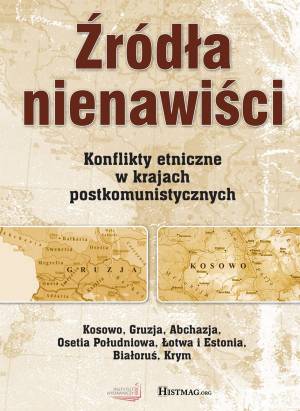 Zainteresował Cię temat konfliktów na Kaukazie? Polecamy książkę „Źródła Nienawiści: Konflikty etniczne w krajach postkomunistycznych” – wspólny projekt wydawniczy „Histmaga” i Instytutu Wydawniczego Erica.
Zainteresował Cię temat konfliktów na Kaukazie? Polecamy książkę „Źródła Nienawiści: Konflikty etniczne w krajach postkomunistycznych” – wspólny projekt wydawniczy „Histmaga” i Instytutu Wydawniczego Erica. Much was done to improve coordination between the units – for instance a clear command system was created. Air and artillery attacks were better prepared and synchronised with army operations. To avoid misunderstandings between different forces (MoD, MVD, etc.) when they had to cooperate, they often were given separate aims. Another method was to give control over the units to commanders who were friends. Although improvements were substantial, some problems persisted. MoD and MVD commanders were arguing about their authorities, coordination between Russia and loyalist militia wasn’t especially effective.
Russians realised that during the first war they were losing not only the battles, but also the support of the press and the public, which in modern warfare is vitally important to achieve success. Before the second war a new factor of the security doctrine was introduced – a strict control over the press. In my opinion, it was effective, and this time Russians believed that the war is just and necessary.
Although much was done to improve the quality of army, some old problems were present as well. We could see lack of really qualified personnel both in air and ground forces and Russian army was still struggling with insufficient number of NCO’s. Casualty level was also high, but lower than in the first war. According to the official data, almost 5000 soldiers were killed from 1999 to 2002, also in the result of the fratricide. War in Chechnya still isn’t over, but Russia controls most of the republic’s territory and is trying to initiate a stabilisation process.
Conclusions
As we could see, Russian approaches to the first and the second Chechen conflicts were different. During the first war, world was shocked by Russian ineffectiveness in dealing with the rebels, coordination problems and finally the defeat. Agreement with the Chechens in 1996 was a humiliation to the Federal Republic, but Russia drew a conclusion from the first conflict and adopted some policies to change its army. We can say that they learned their lesson and improved things such as: cooperation, tactical thinking or dealing with the press. Some problems like bulling, alcoholism, lack of NCO’s, low salaries, conscript army and old equipment are still present in Russian army, but in my view the situation is getting better. President Dmitry Medvedev recently announced an army reform plan, but for its results we will have to wait at least for a couple of years.
See also
Bibliography
- Baev P, Will Russia Go for a Military Victory in Chechnya? (Sandhurst, Confict Studies Research Centre, 2000).
- Blandy C.W., Chechnya: Two Federal Interventions an Interim Comparison and Assessement (Sandhurst, Conflict Studies Research Centre, 2000).
- De Hass M., Russian Security and Air Power 1992-2002 (London, Routledge, 2004).
- Dunlop J. B., Russia Confronts Chechnya: Roots of a Separatist Conflict (Cambridge, Cambridge University Press, 1998)
- Evangelista M., The Chechen Wars: Will Russia Go the Way of the Soviet Union? (Washington, Brookings Institution Press, 2002).
- Herd G. P., ‘The 'Counter-Terrorist Operation' in Chechnya: 'Information Warfare' Aspects’, The Journal of Slavic Military Studies, 13:4 (2000), pp. 57-83.
- Herspring D. R., ‘Undermining Combat Readiness in the Russian Military 1992-2005’, Armed Forces and Society, Vol. 32, No. 4 (2006), page: 513-531.
- Jamestown Foundation, Chechnya Weekly, 4:5 (2003), no page numbers.
- Litvinenko A., Felshtinsky Y., Blowing Up Russia. (New York, Encounter Books, 2007).
- Main S. J., North Caucasus Military District: Defending Russia’s Interests in the Caucasus (1996-August 1999) (Sandhurst, Conflict Studies Research Centre, 2000).
- Marshall-Hasdell D., Russian airpower in Chechnya (Sandhurst, Conflict Studies Research Centre, 1996).
- Olkier O., Russia’s Chechen Wars 1994-2000 – Lessons from Urban Combat (Santa Monica, RAND, 2001).
- Orr M., ‘Better or just not so Bad? An Evaluation of Russian Combat Effectiveness in the Second Chechen War’, in The Second Chechen War, edited by A. Aldis (Sandhurst, Strategic and Combat Studies Institute, 2000), pp. 82-100.
- Seely R., Russo-Chechen conflict, 1800-2000: a deadly embrace (London: Frank Cass Publishers, 2001).
Edited by: Kamil Janicki
